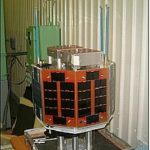UniSat-4 is the fourth educational microsatellite of the UNISAT program*, built and designed by students and professors of the research GAUSS Group of the Laboratory at Scuola di Ingegneria Aerospaziale of University of Rome “La Sapienza”.

UniSat-4
* small satellites for Space Education, whose design, fabrication, ground test, preparation to the launch and ground operations are carried out by the GAUSS Laboratory Group.
Characteristics
- UniSat-4 structure is based on the design of the previous three satellites, an octagonal prism (150mm each side and 250 mm the height) realized in honeycomb with four alluminium “sandwich” trays assembled by columns, where the subsystems are located. Its mass weighted almost 13kg
- Power: photovoltaic system and Ni-Cd batteries (connected)
- Passive magnetic attitude stabilization system to stabilize the spacecraft
- Orbit: Sun-synchronous orbit, altitude = 500/750 km, inclination = 98º
- S-band transmitter, uplink receiver frequencies 436.450MHz, power 2W
- Commercial off-the-shelf components
Mission Objectives
- Promoting Space culture
- Stimulating Space engineering students practical trainings
- Technology experiments: tests of the behaviour in Space environment of terrestrial solar cells; Earth magnetic field and measurements for attitude determination; communiaction links test
- Plasma parameter measurements
- Experimental sails
- TPS (Triple Probe System) for pre-earthquake analysis
- GPS (navigation) experiment
- MPPT(Maximum Peak Power Tracking)
Payloads on board
- Two COTS Cameras with different resolution
- COTS Magnetometers
- Triple junction solar arrays
- Peak power tracking MPPT
- Deorbiting re-entry device innovative passive mechanism developed by GAUSS (SIRDARIA – Spacecraft Integrated Reentry Device Aero Resistant Increasing Area
- GPS receiver
- Langmuir Probe (INAF, IFSI)
- S-band transmitter installed onboard digital communication channel in the UHF/VHF bands
The Launch
The launch took place on July 26, 2006 from Baikonur with DNEPR rocket from Baikonur Cosmodrome, Kazakhstan.
UniSat-4 formed part of a record Cluster launch of 18 university satellites: the LV (DNEPR rocket from ISC Kosmotras) hosted onboard 14 CubeSats* from 10 different universities and one Company, coordinated by California Polytechnic State University (CalPoly) weighting 1kg each and measuring 10x10cm; plus the Bielorus satellite Belka 1 for Earth observation (weighting 700kg), UniSat-4 and the Italian PiCPoT educational microsatellite developed and built by the University Politecnico di Torino (2,5 kg, cubic shape).
* ION (Illinois Observing Nanosatellite of the University of Illinois); SACRED (Study of the Action of Cumulative Radiation on Electronic Devices of the University of Arizona); KUTESat Pathfinder (Kansas Universities’ Technology Evaluation); ICEcube-1,-2 (Ionospheric Scintillation Experiment of Cornell University, Ithaca, NY); RinconSat (University of Arizona); SEEDS (Space Engineering Educational Satellite of Nihon University, Tokyo, Japan); HAUSat-1 (Hankuk Aviation University satellite-1, Seoul, South Korea); nCube-1 (Norsk Romsenter, Norway); MEROPE (Montana Earth-Orbiting Pico-Explorer of Montana State University); Baumanets 1 (NPO Mashinostroyeniya and Bauman Moscow State Technical University, Russia); PolySat-1, -2 CalPoly, San Luis Obispo, CA; AeroCube-1 (Aerospace Corporation, El Segundo, CA); Mea Huaka’I/Voyager (University of Hawaii).
This time the launch was not successful, as the DNEPR had an issue after 74 seconds after launch.
